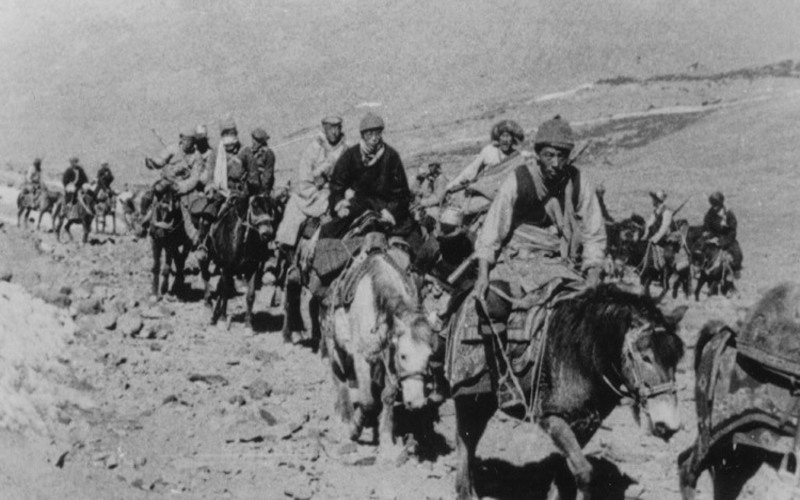
The 14th Dalai Lama fleeing Tibet into exile with Khampa
March 31st holds profound significance in the life of His Holiness the 14th Dalai Lama, marking a pivotal moment in his journey that has shaped the course of Tibetan history and global spirituality. On this day in 1959, the Dalai Lama, along with a group of followers, crossed the border into India, seeking refuge from the political turmoil engulfing Tibet. This event marked the beginning of a new chapter in his life and the Tibetan struggle for freedom, as well as a symbol of resilience, hope, and determination.
The journey into exile was not merely a physical relocation but a spiritual and moral stance against oppression and injustice. It was a courageous act of defiance against the Chinese occupation of Tibet and a testament to the Dalai Lama’s unwavering commitment to the welfare of his people. Faced with the prospect of violence and persecution, His Holiness chose the path of non-violence and compassion, embodying the principles of peace and resilience that he continues to advocate for to this day.
The escape into exile was a harrowing ordeal, fraught with danger and uncertainty. Yet, it was also a moment of profound clarity and conviction, as His Holiness resolved to uphold the Tibetan identity, culture, and values in the face of adversity. The journey across the treacherous Himalayan terrain symbolized the resilience and determination of the Tibetan people, who refused to be silenced or subjugated by external forces.
Upon reaching India, His Holiness found sanctuary and support from the Indian government, which granted asylum to him and his followers. This act of humanitarianism laid the foundation for the Tibetan diaspora in India and paved the way for the establishment of Tibetan institutions and communities in exile. Despite being far from their homeland, Tibetans in exile have worked tirelessly to preserve their cultural heritage, promote education, and foster unity and solidarity among their people.
For His Holiness, March 31st serves as a poignant reminder of the sacrifices made by the Tibetan people and the ongoing struggle for justice and freedom. It is a day of reflection, gratitude, and renewed determination to continue the fight for Tibet’s autonomy and the preservation of its unique cultural and spiritual heritage. Through his tireless advocacy and unwavering commitment to peace, His Holiness has emerged as a global symbol of compassion, wisdom, and moral leadership, inspiring millions around the world to pursue a path of empathy, understanding, and reconciliation.
As we commemorate March 31st, let us reaffirm our solidarity with the Tibetan people and our commitment to supporting their aspirations for freedom, human rights, and self-determination. Let us draw inspiration from the Dalai Lama’s courageous journey into exile and his steadfast dedication to the principles of non-violence, compassion, and justice. And let us work together to build a more peaceful and harmonious world, where the rights and dignity of all individuals are respected and upheld.
Here are the important events surrounding the day before His Holiness the Dalai Lama left Tibet and after he arrived in India:
Before Leaving Tibet:
1. March 10, 1959: General Zhang Chenwu of Communist China extends an invitation to the Dalai Lama to attend a theatrical show by a Chinese dance troupe, leading to rising anxiety among the Lhasa population.
2. March 17, 1959: During a consultation with the Nechung Oracle, the Dalai Lama receives an explicit instruction to leave the country due to the increasing threat to his life.
3. March 17, 1959 (Evening): The Dalai Lama, disguised as a common soldier, slips past a massive throng of people along with a small escort and proceeds towards the Kyichu river, where he is joined by the rest of his entourage.
After Arriving in India:
1. March 31, 1959: Three weeks after escaping Lhasa, His Holiness and his entourage reach the Indian border, where they are escorted by Indian guards to the town of Bomdila in the present-day Indian state of Arunachal Pradesh. This marks the official arrival of the Dalai Lama in India.
2. April 20, 1959: Shortly after his arrival in Mussoorie on April 20, the Dalai Lama meets with the Indian Prime Minister to discuss rehabilitating Tibetan refugees.
3. June 20, 1959: The Dalai Lama calls a press conference in Mussoorie, during which he formally repudiates the Seventeen-Point Agreement signed under duress in Beijing on May 23, 1951.
These events represent key moments in the Dalai Lama’s journey from Tibet into exile in India, marking the beginning of a new chapter in his life and the Tibetan struggle for freedom.